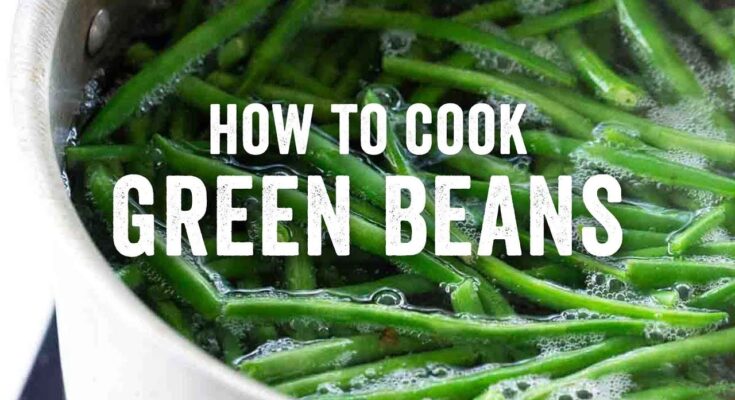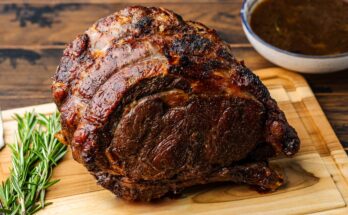Fresh Green Beans Recipe: There’s something incredibly satisfying about biting into a crisp, tender green bean. Fresh green beans aren’t just a side dish—they’re a highlight on any plate when done right. Whether you’re prepping a wholesome family dinner or sprucing up a holiday feast, green beans bring vibrant color and fresh flavor to the table. They’re also a powerhouse of nutrients, loaded with fiber, vitamins A, C, and K, and are naturally low in calories. Not to mention, they’re incredibly versatile—you can roast them, sauté them, steam them, or even add them to a salad or stir-fry.
This guide walks you through a foolproof recipe that brings out the best in fresh green beans. You’ll learn how to select them, prepare them, and cook them to perfection using different methods depending on your flavor preference or available kitchen tools. Let’s dig into the ultimate step-by-step process that ensures you end up with green beans that are anything but boring.
Ingredients You’ll Need
To make a delicious green bean dish, you don’t need a pantry full of items. A handful of fresh, simple ingredients will do the trick. Here’s what you’ll need for a basic yet flavorful green bean recipe:
Essential Ingredients:
- 1 pound of fresh green beans (ends trimmed)
- 2 tablespoons olive oil or unsalted butter
- 2–3 garlic cloves (minced)
- Salt and freshly ground black pepper (to taste)
- 1 tablespoon lemon juice or zest (optional, for brightness)
Optional Flavor Boosters:
- Red pepper flakes for a kick
- Chopped shallots or onions for depth
- Crumbled bacon or pancetta for a smoky touch
- Toasted almonds or pine nuts for crunch
- Fresh herbs like thyme, parsley, or dill for aroma
These ingredients serve as a great starting point. Feel free to experiment and tailor the seasoning based on what you have on hand or your personal taste preferences.
Choosing the Best Green Beans
When it comes to green beans, freshness is key. The better the quality of the beans you start with, the better your dish will taste. So how do you pick the best ones?
Here’s what to look for:
- Color: Choose green beans that are vibrant and rich in color. Avoid beans with brown spots, blemishes, or signs of wilting.
- Texture: Fresh green beans should feel firm and crisp. If they feel rubbery or bend without snapping, they’re probably past their prime.
- Size: Medium-sized beans are ideal. They cook evenly and offer a perfect texture—not too tough, not too soft.
- Snap Test: Try snapping a bean in half. If it breaks cleanly with a “snap,” it’s fresh. If it bends or feels limp, it’s best to leave it behind.
Pro Tip: If you can, shop at a local farmers market. The green beans there are often fresher and more flavorful than grocery store options, and you’ll also be supporting local growers.
Preparation Before Cooking
Before you toss those beans into a hot pan, a bit of prep work is necessary to get them ready for cooking. It’s simple, but these small steps make a huge difference in taste and texture.
1. Washing the Green Beans: Place the beans in a large colander and rinse them thoroughly under cool running water. Shake off excess moisture. This step removes any dirt, debris, or pesticides lingering on the surface.
2. Trimming the Ends: Line up a handful of beans and trim the stem ends using a sharp knife or kitchen shears. The tip end is edible, but the stem end is tough and needs to go. You can also snap off the ends by hand if you prefer a more rustic prep.
3. Prepping Additional Ingredients: While you prep your green beans, go ahead and mince the garlic, zest your lemon, or chop any herbs or toppings you plan to use. Having everything ready makes the cooking process smooth and stress-free.
Once everything is washed, trimmed, and ready, you’re set to cook. The great thing about green beans is how quickly they come together once they hit the heat.
Cooking Methods Explained
Now that your beans are ready, it’s time to choose your cooking method. Each method brings out a different side of the green beans’ flavor and texture. Let’s explore the most popular options.
Blanching
Blanching is a quick cooking method that partially cooks the beans and locks in their bright green color. It’s great if you’re planning to serve green beans cold (like in a salad) or want to finish them later with a quick sauté.
Steps:
- Bring a large pot of salted water to a boil.
- Add the trimmed green beans and cook for 2–3 minutes.
- Immediately transfer the beans to an ice water bath to stop the cooking.
- Drain well before using in another recipe or tossing with dressing.
Blanched beans are tender but still crisp—perfect if you’re going for freshness and simplicity.
Sautéing
Sautéing adds flavor quickly and easily, especially when you throw in garlic, butter, or bacon.
Steps:
- Heat olive oil or butter in a large skillet over medium heat.
- Add garlic or shallots and sauté until fragrant (about 30 seconds).
- Toss in green beans and season with salt and pepper.
- Cook for 7–10 minutes, stirring occasionally, until beans are tender and lightly browned.
This method gives you deeply flavorful beans with just the right amount of bite. Great for pairing with chicken, steak, or fish.
Steaming
Steaming is a great choice if you want to preserve nutrients while keeping the texture tender-crisp. It’s one of the healthiest methods to prepare green beans, making it ideal for clean eating or diet-conscious meals.
Steps:
- Fill a pot with about 1–2 inches of water and bring it to a simmer.
- Place a steamer basket over the pot, ensuring it doesn’t touch the water.
- Add your trimmed green beans to the basket.
- Cover and steam for 5–6 minutes until beans are bright green and just tender.
- Season with salt, pepper, and a drizzle of olive oil or lemon juice after removing from the steamer.
Steamed green beans are soft enough to chew but still hold a delightful crunch. They’re great as a light side dish or tossed into grain bowls.
Roasting
Roasting green beans in the oven gives them a rich, slightly caramelized flavor and a satisfying texture. This method is perfect for those who enjoy a deeper, roasted taste with some crispy edges.
Steps:
- Preheat your oven to 425°F (220°C).
- Toss green beans in olive oil, salt, and pepper.
- Spread them out in a single layer on a baking sheet.
- Roast for 15–20 minutes, flipping halfway through, until they’re tender and slightly charred.
- Finish with lemon zest, grated parmesan, or crushed nuts for added texture.
Roasting transforms green beans from a simple veggie into a gourmet side dish. They’re so good, you might eat them straight off the tray.
How to Season Green Beans Perfectly
Seasoning makes or breaks any dish, and green beans are no different. Here’s how to season them just right, no matter which cooking method you choose.
Basic Seasoning Tips:
- Always season with salt during cooking to enhance flavor.
- Freshly ground black pepper adds just the right kick.
- Garlic and onion (fresh or powder) bring out a savory depth.
Flavor Combos to Try:
- Zesty: Lemon juice + garlic + olive oil
- Savory: Butter + thyme + shallots
- Smoky: Bacon bits + smoked paprika
- Nutty: Toasted almonds + sesame oil
Try mixing and matching to find your favorite combination. Don’t be afraid to get creative!
Tips to Keep Green Beans Crisp and Bright
No one likes soggy or dull-looking green beans. These simple tricks help you maintain their color and crunch.
1. Don’t Overcook: Whether you’re steaming, sautéing, or roasting, watch your cook time. Overcooking leads to mushy beans and faded color.
2. Use Ice Water: After blanching, an ice bath stops cooking instantly and locks in that gorgeous green.
3. Dry Before Cooking: Water on the beans can lead to steaming instead of crisping. Pat them dry before roasting or sautéing.
4. Cook in Batches: Overcrowding your pan or pot can cause uneven cooking. Give the beans space to breathe.
5. Add Acid Last: If you’re using lemon juice or vinegar, add it at the end. Acid can dull the color if added too early in the cooking process.
These tips are simple but make a noticeable difference in the final dish.
Serving Suggestions and Pairings
Green beans are incredibly versatile and can complement almost any main course. Here are some tasty ways to serve them up:
With Protein:
- Serve alongside grilled chicken, steak, or salmon.
- Toss into a stir-fry with tofu or shrimp.
In Salads:
- Chop blanched green beans and mix with cherry tomatoes, feta, and vinaigrette.
- Add to a quinoa or couscous salad for extra crunch and color.
As a Holiday Side:
- Upgrade your Thanksgiving table with green beans almondine.
- Toss roasted green beans with cranberry and goat cheese for a festive twist.
Kid-Friendly Ideas:
- Drizzle with melted cheese or serve with a yogurt dip.
- Try green bean “fries” by roasting with parmesan and breadcrumbs.
No matter how you serve them, fresh green beans bring flavor, color, and nutrition to the plate.
Storage and Reheating Tips
Got leftovers? No worries! Fresh green beans store well and can be revived for another delicious meal if you treat them right.
How to Store Cooked Green Beans:
- Allow the green beans to cool to room temperature before storing.
- Transfer them into an airtight container.
- Refrigerate for up to 4 days.
Can You Freeze Cooked Green Beans? Yes! Blanched or steamed green beans freeze beautifully.
- Place cooled green beans in a single layer on a baking sheet.
- Freeze for 1–2 hours until solid.
- Transfer to a freezer-safe bag or container, and label it with the date.
- Store for up to 3 months.
Reheating Tips:
- Microwave: Reheat in a microwave-safe dish with a splash of water, covered loosely with a lid or damp paper towel. Heat for 1–2 minutes.
- Stovetop: Add a bit of butter or oil to a skillet and sauté until warmed through.
- Oven: For roasted beans, reheat at 350°F (175°C) for 10 minutes to retain crispiness.
Avoid overcooking during reheating to maintain that lovely texture. A quick warm-up is all they need.
Common Mistakes to Avoid
Even with a simple vegetable like green beans, it’s easy to slip up. Avoid these common pitfalls to ensure your dish turns out great every time:
1. Overcooking: This is the most frequent mistake. Mushy beans lose their bright green color and fresh bite. Keep a close eye on the cook time, and remember that green beans continue to cook a little even after being removed from heat.
2. Skipping the Salt: Green beans need seasoning to shine. Salt helps bring out their natural flavor and prevents blandness.
3. Not Trimming the Ends: Those tough, fibrous ends aren’t pleasant to chew. Take a minute to snip them off for a better texture.
4. Cooking Wet Beans: Water clinging to the beans can make them steam instead of crisp. Pat them dry after washing for best results—especially important when roasting.
5. Crowding the Pan: Give green beans space, especially when roasting or sautéing. Crowding causes them to steam and cook unevenly.
Making It a Meal – Green Bean Recipe Variations
You can easily transform green beans from a humble side into the star of the show. Here are some hearty, creative ways to give green beans a full meal glow-up:
Green Bean Stir-Fry:
- Sauté green beans with bell peppers, mushrooms, and tofu or chicken.
- Add soy sauce, garlic, and a dash of sesame oil for a quick Asian-inspired dinner.
Green Bean Pasta:
- Toss blanched green beans with pasta, cherry tomatoes, parmesan, and olive oil.
- Add grilled chicken or shrimp to boost the protein content.
Green Bean Casserole (from scratch!):
- Mix green beans with sautéed mushrooms, a light cream sauce, and crispy onions.
- Bake until bubbling for a comforting, classic favorite.
Green Bean Grain Bowls:
- Pair with brown rice or quinoa, a boiled egg, avocado, and tahini dressing for a nourishing lunch.
These variations not only bring excitement to your meals but also help you use up any extra beans you have lying around.
Why You’ll Love Cooking with Fresh Green Beans
Cooking with fresh green beans is a rewarding experience. They’re not only healthy but also quick to prepare, super adaptable, and work with practically any cuisine. Whether you’re throwing together a weekday dinner or prepping for a special occasion, green beans always fit right in.
Here’s why they’re a kitchen staple:
- They’re cost-effective and widely available.
- You can prep them in bulk and store them easily.
- They pair beautifully with herbs, spices, cheeses, and meats.
- Kids and adults both love them when cooked well.
- You can use them in both hot and cold dishes.
Once you master the basics, green beans become a go-to that never gets old.
FAQs about Fresh Green Beans Recipe
1. How do I choose the best fresh green beans?
Look for bright green beans that are firm, crisp, and snap easily when bent. Avoid beans that are limp, spotted, or discolored.
2. Do I need to trim green beans before cooking?
Yes, it’s best to trim the ends. Simply snap or cut off both tips of each bean before cooking.
3. Should I blanch green beans before sautéing or freezing?
Blanching helps preserve the bright green color and crisp-tender texture. Boil for 2-3 minutes, then plunge into ice water before sautéing or freezing.
4. What seasonings work best with green beans?
Garlic, lemon, butter, olive oil, salt, black pepper, and crushed red pepper flakes enhance the flavor beautifully. Herbs like thyme or parsley are also great additions.
5. Can I cook green beans without boiling them first?
Absolutely. You can roast or sauté them directly for a firmer texture and more concentrated flavor.
6. How long do cooked green beans last in the fridge?
Store cooked green beans in an airtight container. They’ll stay fresh for up to 4 days in the refrigerator.
7. Are green beans healthy?
Yes! Green beans are low in calories and high in fiber, vitamins A, C, and K, as well as folate and antioxidants.
8. Can I use frozen green beans instead of fresh?
Yes, but fresh green beans offer better texture and flavor. If using frozen, thaw and drain well before cooking.
Conclusion
Fresh green beans are one of those veggies that are anything but boring when done right. With just a few ingredients and a handful of techniques, you can turn them into something truly crave-worthy. Whether you steam them, roast them, or toss them in garlic butter, green beans offer a burst of color, flavor, and crunch that works with almost any meal.
Next time you’re planning dinner, give green beans a starring role. They’re quick to cook, easy to flavor, and an all-around crowd-pleaser. Don’t be surprised if you start keeping a steady supply on hand—once you start making them the right way, there’s no going back.



